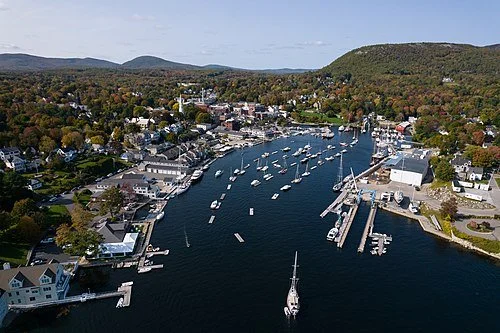
Where will the coastal year-rounders live?
Stonington waterfront in1915
Aerial view of fancy summer resort town Camden, Maine, from the harbor
—Photo by King of Hearts
Adapted from Robert Whitcomb’s “Digital Diary,’’ in GoLocal24.com
‘Many coastal communities in New England face severe housing shortages for year-round residents of modest means. Around here, Nantucket, Martha’s Vineyard and Block Island are infamous for this problem.
Consider Stonington, Maine, on Deer Isle. There, 80 percent of its shorefront is now owned by non-residents (mostly summer people), as are 56 percent of that fishing (mostly lobsters) port’s downtown properties, according to a report in the Portland Press Herald
The usually affluent summer folks bid up real estate prices to levels unaffordable to most year-rounders.
So where will the carpenters, yard-work people, plumbers, electricians and schoolteachers live? Perhaps some elderly summer people will leave their summer McMansions to towns to be converted into affordable housing. Just joking. But something must be done if these towns are going to have enough of the locals who make communities viable for year-round and summer people. That includes zoning changes and/or having states subsidize the construction of new housing in some places.
A great artist paints craftsmen on the Maine Coast
“Shipyard,’’ painted in 1916 by George Bellows (American, 1882-1925). It can be seen at the Art Complex Museum, Duxbury, Mass.
The museum says:
'‘The museum's permanent collection contains multiple works by American artist George Bellows. Bellows spent a few summers on the coast of Maine and its offshore islands in the early 1910s. The shipyard in Camden particularly drew his attention, and he created a series of paintings based on his time there, including ‘Shipyard’’’.
Camden Harbor. Camden and the Maine Coast in general have a long and famous tradition of boat/shipbuilding, though Camden has long been best known as a summer place for rich Northeast Corridor people (especially old-money WASPS) and others, many of them with fancy boats that they cruise and race in.
Sliding down winter in Camden
At the U.S. National Toboggan Championships, in Camden, Maine.
Camden, Maine, on the Pine Tree State's Mid-Coast and, very unusual for New England, with (low) mountains behind its gorgeous harbor, is a famed summer place for the affluent "from away''. But it's beautiful and fun year round.
The high point of the winter is the annual U.S. National Toboggan Championships, this year to be held Feb. 9-11, as usual at the Camden Snow Bowl. It includes a party in the woods, with a bonfire, food and music. In warmer weather, admire Camden's famous schooner fleet.
LePage eyes big 'nonprofits' for property-tax revenue
"Misty Morning, Coast of Maine,'' by ARTHUR PARTON.
Maine Gov. Paul LePage can sometimes sound like a lunatic. The most amusing example of this might be his ouster of a mural depicting the Pine Tree State's labor history from the state Department of Labor's building in Augusta. He doesn't like unions!
It bears noting, by the way, that both times he's been elected governor he received a minority of votes but won anyway because his Democratic and independent foes split the relatively liberal vote, thus electing Mr. LePage, a Tea Party Republican, governor of a state that generally leans slightly left.
It's an interesting state socio-economically: some strips of wealth (especially in the summer) along the immediate coast from the New Hampshire line to Mt. Desert Island and pockets of affluence in a couple of towns on the eastern edge of the White Mountains but generally a lot of poverty inland and in northern Maine. Sort of an Arctic Appalachia set off from the cold-water Riviera of such plush towns as Camden and York and Bar Harbor.
However, the sometimes fiery Mr. LePage is on to something right in proposing to end the property-tax exemption of some big nonprofits.
The fact is that many big "nonprofits'' are hugely profitable for their senior executives, who pay themselves more than they'd earn in many equivalent positions of responsibility in the for-profit sector.
Rather than paying out profit to shareholders in dividends and capital gains, the organizations enrich the "nonprofit'' execs with fat, always inflation-proof pay and Cadillac "fringe'' benefits virtually unseen in the officially "for-profit'' sector.
Some of these big ''nonprofits'' can also be goldmines for members of their boards who use them to make and maintain business deals and even directly steer money to their enterprises.
Some big "nonprofits'' endlessly expand their administrative staffs into vast populations of vice presidents, etc., as part of the CEO's empire building. (A few years ago I was approached to work as an executive for a large, rich "nonprofit''. I was astonished at the overstaffing of administrators, the endless time burned up in meetings, the geological time taken to make even a minor decision. I'm more used to the much harsher and more decisive world of regular business, which, if anything, has become even more "heartless'' in the past 30 years.)
Most nonprofits, of course, are just scraping along. I have served on the boards of a few of these and hugely admire the work they do to keep their civic missions going, though they're probably are too many nonprofits. Lots of cannibalization of charitable money going on.
Rather, I'm talking here about some some big ones, especially in education and healthcare.
In any event, far too many citizens forget that when an outfit has ''nonprofit'' status or a sexy company gets a sweetheart tax break because a public official wants to take credit for the company's (usual broken) promise of new jobs, and get into a photo op, that others must make up the lost tax revenue to pay for the better schools, roads, bridges, health inspectors and so on that we all need.
All hail Governor LePage for raising this issue.







